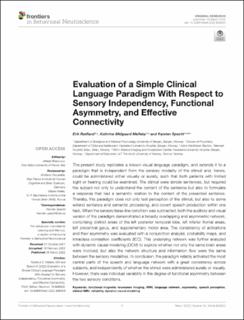| dc.contributor.author | Rødland, Erik | |
| dc.contributor.author | Melleby, Kathrine Midgaard | |
| dc.contributor.author | Specht, Karsten | |
| dc.date.accessioned | 2022-05-27T12:14:20Z | |
| dc.date.available | 2022-05-27T12:14:20Z | |
| dc.date.created | 2022-03-25T09:37:10Z | |
| dc.date.issued | 2022-03-03 | |
| dc.identifier.issn | 1662-5153 | |
| dc.identifier.uri | https://hdl.handle.net/11250/2996475 | |
| dc.description.abstract | The present study replicates a known visual language paradigm, and extends it to a paradigm that is independent from the sensory modality of the stimuli and, hence, could be administered either visually or aurally, such that both patients with limited sight or hearing could be examined. The stimuli were simple sentences, but required the subject not only to understand the content of the sentence but also to formulate a response that had a semantic relation to the content of the presented sentence. Thereby, this paradigm does not only test perception of the stimuli, but also to some extend sentence and semantic processing, and covert speech production within one task. When the sensory base-line condition was subtracted, both the auditory and visual version of the paradigm demonstrated a broadly overlapping and asymmetric network, comprising distinct areas of the left posterior temporal lobe, left inferior frontal areas, left precentral gyrus, and supplementary motor area. The consistency of activations and their asymmetry was evaluated with a conjunction analysis, probability maps, and intraclass correlation coefficients (ICC). This underlying network was further analyzed with dynamic causal modeling (DCM) to explore whether not only the same brain areas were involved, but also the network structure and information flow were the same between the sensory modalities. In conclusion, the paradigm reliably activated the most central parts of the speech and language network with a great consistency across subjects, and independently of whether the stimuli were administered aurally or visually. However, there was individual variability in the degree of functional asymmetry between the two sensory conditions. | en_US |
| dc.language.iso | eng | en_US |
| dc.publisher | Frontiers | en_US |
| dc.rights | Navngivelse 4.0 Internasjonal | * |
| dc.rights.uri | http://creativecommons.org/licenses/by/4.0/deed.no | * |
| dc.title | Evaluation of a Simple Clinical Language Paradigm With Respect to Sensory Independency, Functional Asymmetry, and Effective Connectivity | en_US |
| dc.type | Journal article | en_US |
| dc.type | Peer reviewed | en_US |
| dc.description.version | publishedVersion | en_US |
| dc.rights.holder | Copyright 2022 the authors | en_US |
| dc.source.articlenumber | 806520 | en_US |
| cristin.ispublished | true | |
| cristin.fulltext | original | |
| cristin.qualitycode | 1 | |
| dc.identifier.doi | 10.3389/fnbeh.2022.806520 | |
| dc.identifier.cristin | 2012459 | |
| dc.source.journal | Frontiers in Behavioral Neuroscience | en_US |
| dc.identifier.citation | Frontiers in Behavioral Neuroscience. 2022, 16, 806520. | en_US |
| dc.source.volume | 16 | en_US |

